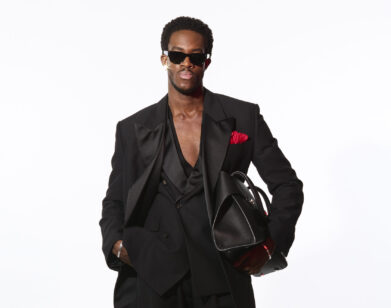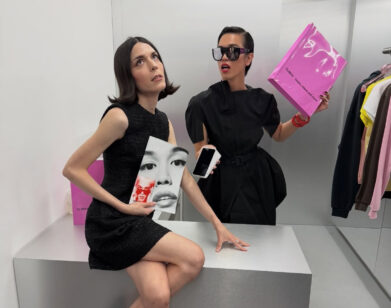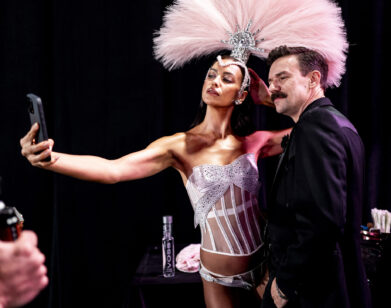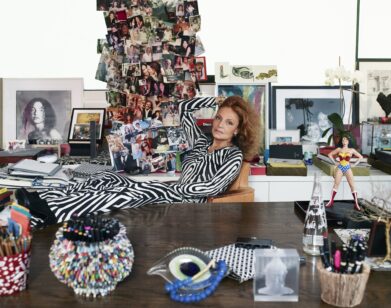Incubating: Ruby Kobo
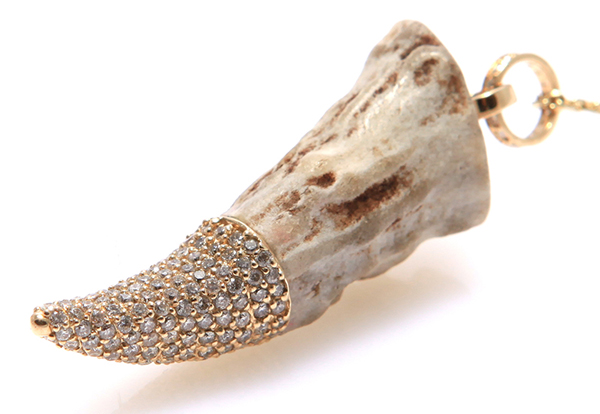
PHOTOS COURTESY OF RUBY KOBO
“This has all happened in like the past year,” says Yuvi Alpert of the rapid ascent of the jewelry line he co-designs with Danna Kobo, called Ruby Kobo. Three years ago, Alpert was studying jewelry design and finance and traveling through Southeast Asian. He met Kobo in Miami, where they were both wearing pieces they’d made. Soon, they were in business and, now, just two years later, they’ve been shortlisted by the CFDA for their Incubator Program. Here, the two designers talk about how the tabloids have helped them take off, redoing the Hamsa, and how expensive is too expensive for real jewelry.
YUVI ALPERT: Right when we got started, with one of the first pieces we sold at Fred Segal in LA, our publicist and said, “Rihanna’s been buying a lot of your stuff.” We had just gotten to LA, and we ended up making the horn pieces with her in mind. It took us about a year to figure out how to include the horn pieces in our collection, until we realized that we were literally going to have to make a mold for each piece.
FABIOLA BERACASA: Did Rihanna end up getting it?
ALPERT: Yeah, she bought them—
DANNA KOBO: But unfortunately, it was the night of the whole thing that she had…
BERACASA: So basically your horn was involved in the incident.
ALPERT: Don’t blame us!
BERACASA: But the horn was there.
ALPERT: No, I don’t know if the horn was there.
BERACASA: It could have been!
KOBO: We have our PR company now, and we love them, but before we could afford them, we were seeing celebrity responses by turning on the TV.
BERACASA: Who was the first celebrity who wore your pieces?
KOBO: Yuvi turned on the TV and saw Michelle Obama in out stuff. He was so excited. Then I had three in the same week. The first was Russell Brand. Then I was watching the BET Awards and Kanye West comes on with a white sweater and this necklace on and I vaguely recognized it, until I paused and zoomed. He bought it independently. Then Lionel Richie, the next week, on the American Idol finale, which is one of my favorite shows.
BERACASA: I know a lot of your jewelry has stories behind it, and also that you’re quite spiritual. What’s the philosophy behind your jewelry?
KOBO: I’m very very into Kabbalah. My mother studied Kabbalah before it was cool, in the ‘80s. And you always see the Hamsa [the small outstretched hand] with the red string. Are you familiar with what it means?
BERACASA: I am, but why don’t you tell our reader.
KOBO: It means different things, but for me, the most important thing is the evil eye. I’m very, very superstitious, and every time I’m wearing something expensive and someone wishes they had it, want to give me the look of—
BERACASA: The evil eye?
KOBO: Yeah. I was always taught to brush my forehead as way of saying “back at you,” or not even “back at you,” just “away from me.” If I feel the burning when somebody is giving off bad energy, I just put my design hand out. I really believe in that. So Hamsa is really important to me, but they’re usually so flat and ugly. I wanted a real hand. I always want it to look real. I want it to be gold and small, and I want to carry it with me wherever I go.
BERACASA: They’re actually red.
KOBO: As red as you can get. I wanted it blood red.
BERACASA: I personally am not superstitious, but I don’t think it could hurt.
KOBO: Do you believe in energy?
BERACASA: Of course.
KOBO: You know, if you have photos on the Internet or on Facebook, people who see that with negative intentions, that bad energy is coming on you and making you ugly and bad.
BERACASA: Well, yes, but that’s a whole other conversation, not an interview about your jewelry. But I’m not superstitious, because for me it’s too time consuming in my head…
KOBO: It’s not really based on superstition; it’s just more about energy. It’s not like my whole line is voodoo.
BERACASA: No, of course not. This is centuries and centuries old; it’s not like, “Hey, look at me, this is my superstitious tree bark.” I think it’s beautiful. And I’ve never seen a hand that was done this well.
KOBO: I put a lot of attention into the detail. I was traveling two summers ago, when I first made the Hamsa piece, and I was wearing it. I was in Kuwait for my best friend’s wedding, and people there were stopping me. Then I went to Israel, and people there were stopping me. I went to Turkey and Greece, people there were stopping me. They all are different religions, different backgrounds, different everything, and they all were like, “Hamsa, Hamsa.”
BERACASA: What’s the most difficult thing about working together? Do you argue?
KOBO: I think it’s very important that we’re both opposite sexes. I’ve heard so many horror stories about partners breaking up. And usually it’s the same: girl-girl, guy-guy. Even with brothers, even with family members.
BERACASA: So you really haven’t encountered many difficulties.
KOBO: No, it’s really just work. We work really hard. And when you care so much about the same goals, there’s really nothing to fight about. I mean, if you really both just want to be successful, and you both just love the product, what is there to fight about? We’re completely, completely different as far as aesthetics. For instance, he doesn’t like this chair I’m sitting on, but I like this chair.
BERACASA: So you are total opposites except when you come together for jewelry?
KOBO: I’d say two out of ten times we disagree. And it would probably be because there weren’t enough diamonds in it, or gold. He likes it very natural. And he’s probably yelled at me a million times, “No, we can’t make that, it’ll be too expensive.”
BERACASA: And what ends up happening? Does it become too expensive?
KOBO: We compromise.

